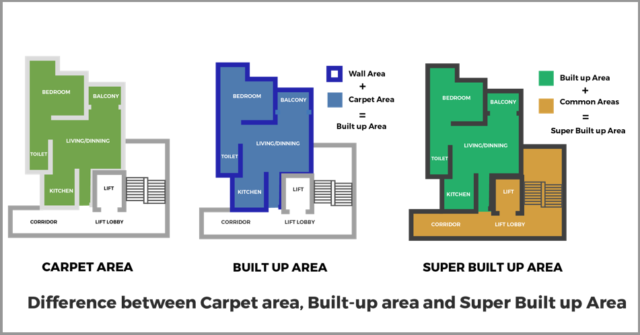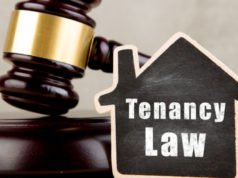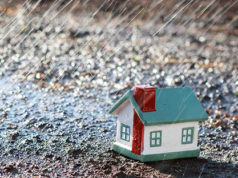Buying a home is a difficult task, especially when it is your first time. There are a number of real estate jargon that every home buyer should be aware of, before starting your search for the perfect home. To help you navigate through the home-buying process, here are some of the basic real estate terms that you should know. Read on to know what is the carpet area, built-up area, and super built-up area.
Carpet area
Carpet area is the area that can actually be covered by a carpet, or the area of the apartment excluding the thickness of inner walls. Carpet area does not include the space covered by common areas such as lobby, lift, stairs, play area, etc. Carpet area is the actual area you get for use in a housing unit. So when you are in search of a house, look at the carpet area and then make your decision, because that is the number that will give you an idea of the actual space at your disposal. Focusing on the carpet area will help you understand the usable area in the kitchen, bedroom, living room, etc. Nowadays, many builders do not even mention carpet area at first and usually charge on the basis of built-up area or super built-up area. Carpet area is usually around 70% of the built-up area.
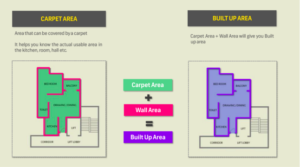
Built-up area
Built-up area is the area that comes after adding carpet area and wall area. Now, the wall area does not mean the surface area, but the thickness of the inner walls of a unit. The area constituting the walls is around 20% of the built-up area and totally changes the perspective. The built-up area also consists of other areas mandated by the authorities, such as a dry balcony, flower beds, etc., that add up to 10% of the built-up area. So when you think about it, the usable area is only 70% of the built-up area. So, if the built-up area says 1,200 sq ft, it means around 30% (360 sq ft) is not really usable, and the actual area you will get to use is only the remaining 840 sq ft.
Super built-up area
Super built-up area is a builder’s BFF! It is the area calculated by adding the built-up area and common area that includes the corridor, lift lobby, lift, etc. In some cases, builders even include amenities such as a pool, garden and clubhouse in the common area. Selling on the basis of the super built-up area not only gives a wrong sense of the area of the house, but also reduces the per square feet cost of the house. A developer/builder charges you on the basis of the super built-up area which is why it is also known as ‘saleable’ area.
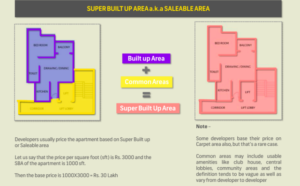
Now let us consider this case – the rate is Rs 2,000 per sq ft and the super built-up area is 1,200 sq ft, then the base cost will come up to 24 lakhs.
When there is more than one apartment on a floor, the super built-up area is calculated in a different manner. Let us assume this is the case.
— The area of Apartment 1 is 1,000 sq ft
— The area of Apartment 2 is 2,000 sq ft
— The total common area is 1,500 sq ft, out of which the share of Apartment 1’s common area is 500 sq ft while the share of Apartment 2’s common area is 1,000 sq ft.
Then, the super built-up area of Apartment 1 is 1,500 sq ft and of Apartment 2 is 3,000 sq ft. The super built-up area, as seen in this example, is divided in the ratio of the apartments’ built-up areas (in this case 1:2).
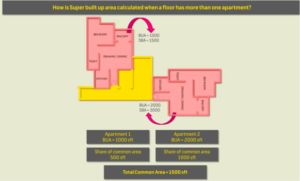
Before RERA came into existence, most real estate developers used to sell apartments on the basis of super built-up area which consists the common area as well. Considering the fact that builders and developers used to price their apartments based on super built-up or ‘saleable’ area, being unaware of the fundamental difference between carpet area and built-up area and other terms leaves one running blind.
Often the actual usable area is much lower than the super built-up area. Some builders take into account the carpet area while charging you but this is only in the rarest of the rare cases. 90% of the developers calculate the base cost on the basis of the super built-up area; the more the amenities the higher the super built-up area.
Real estate can be complicated and you cannot change the rules and practices but you definitely can make an informed decision when you are aware of the various types of calculations for square footage, a seemingly major but actually simple job!
Source: Housing News







